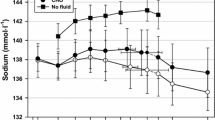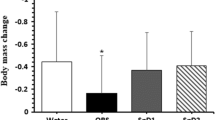Abstract
This study examined the effect of the sodium content of drinks on the rehydration process after exercise. Six healthy male volunteers were dehydrated by a mean (SEM) of 1.9(0.0) % of body mass by intermittent cycle exercise in a warm (32°C), humid (54% RH) environment. Subjects exercised on four occasions at weekly intervals with each trial beginning in the morning, 3 h after a standard breakfast. Over a 30-min period beginning 30 min after the end of exercise, subjects ingested one of the four test drinks in a volume equivalent to 1.5 times their body mass loss. Drink composition was constant except for the sodium (and matching anion) content. Sodium content of drinks A, B, C and D was 2, 26, 52 and 100 mmol · l−1, respectively. Treatment order was randomised using a four-way crossover incomplete block design. Blood and urine samples were obtained before exercise, immediately before and after the rehydration period and at 0.5, 1.5, 3.5 and 5.5 h after the end of the rehydration period. Data were analysed by parametric or non-parametric statistical tests as appropriate. The volume of fluid consumed was the same on all trials [2045(45) ml]. From the 1.5-h sample onwards, a significant treatment effect on cumulative urine output was apparent, with the volume excreted being inversely related to the sodium content of the drink consumed. By the end of the trial, subjects were in net negative fluid balance on trials A [by 689(124) ml] and B [by 359(87) ml]; on trials C [−2(79) ml] and D [+98(67) ml], subjects were approximately euhydrated. Cumulative urinary sodium output was higher on treatment D than on the other trials after 5.5 h. Plasma volume was lower after exercise than before; on trials B, C and D, plasma volume was higher than the pre-exercise value from 0.5 h after the end of the rehydration period onwards. On trial A, plasma volume was higher than the pre-exercise value at 3.5 and 5.5 h after the end of the rehydration period. At 1.5 h after the end of the rehydration period, the increase in plasma volume was greater on trials C and D than on trial A. These results suggest that the fraction of the ingested fluid that was retained was directly related to the sodium concentration.
Similar content being viewed by others
References
Costill DL (1977) Sweating: its composition and effects on body fluids. Ann NY Acad Sci 301:160–174
Costill DL, Sparks KE (1973) Rapid fluid replacement following thermal dehydration. J Appl Physiol 34:299–303
Dill DB, Costill DL (1974) Calculation of percentage changes in volumes in blood, plasma and red cells in dehydration. J Appl Physiol 37:247–248
Edelman JS, Leibman J (1959) Anatomy of body water and electrolytes. Am J Med 27:256–277
Gonzalez-Alonso J, Heaps CL, Coyle EF (1992) Rehydration after exercise with common beverages and water. Int J Sports Med 13:399–406
Lambert CP, Costill DL, McConnell GK, Benedict MA, Lambert GP, Robergs RA, Fink WJ (1992) Fluid replacement after dehydration: influence of beverage carbonation and carbohydrate content. Int J Sports Med 13:285–292
Lentner C (ed) (1981) Geigy Scientific Tables, 8th edn. Ciba-Geigy, Basle
Maughan RJ (1991) Carbohydrate-electrolyte solutions during prolonged exercise. In: Lamb DR, Williams MH (eds) Perspectives in exercise science and sports medicine, vol. 4. Brown and Benchmark, Carmel, pp 35–85
Maughan RJ, Owen JH, Shirreffs SM, Leiper JB (1994) Post-exercise rehydration in man: effects of electrolyte addition to ingested fluids. Eur J Appl Physiol 69:209–215
Moore FD, Olesen KH, McMurrey JD, Parker HV, Ball MR, Boyden CM (1963) The body cell mass and its supporting environment. Saunders, Philadelphia
Nadel ER, Mack GW, Nose H (1990) Influence of fluid replacement beverages on body fluid homeostasis during exercise and recovery. In: Gisolfi CV, Lamb DR, (eds) Perspectives in exercise science and sports medicine, vol 3.Fluid homeostasis during exercise. Benchmark, Carmel, pp 181–205
Nose H, Mack GW, Shi X, Nadel ER (1988a) Role of osmolality and plasma volume during rehydration in humans. J Appl Physiol 65:325–331
Nose H, Mack GW, Shi X, Nadel ER (1988b) Involvement of sodium retention hormones during rehydration in humans. J Appl Physiol 65:332–336
Sawka MN (1992) Physiological consequences of hypohydration: exercise performance and thermoregulation. Med Sci Sports Exerc 24:657–670
Verde T, Shephard RJ, Corey P, Moore R (1982) Sweat composition in exercise and in heat. J Appl Physiol 53:1540–1545
Walker-Smith JA (1992) Recommendations for composition of oral rehydration solutions for children of Europe. J Pediatr Gastroenterol 14:113–115
Author information
Authors and Affiliations
Rights and permissions
About this article
Cite this article
Maughan, R.J., Leiper, J.B. Sodium intake and post-exercise rehydration in man. Europ. J. Appl. Physiol. 71, 311–319 (1995). https://doi.org/10.1007/BF00240410
Accepted:
Published:
Issue Date:
DOI: https://doi.org/10.1007/BF00240410




